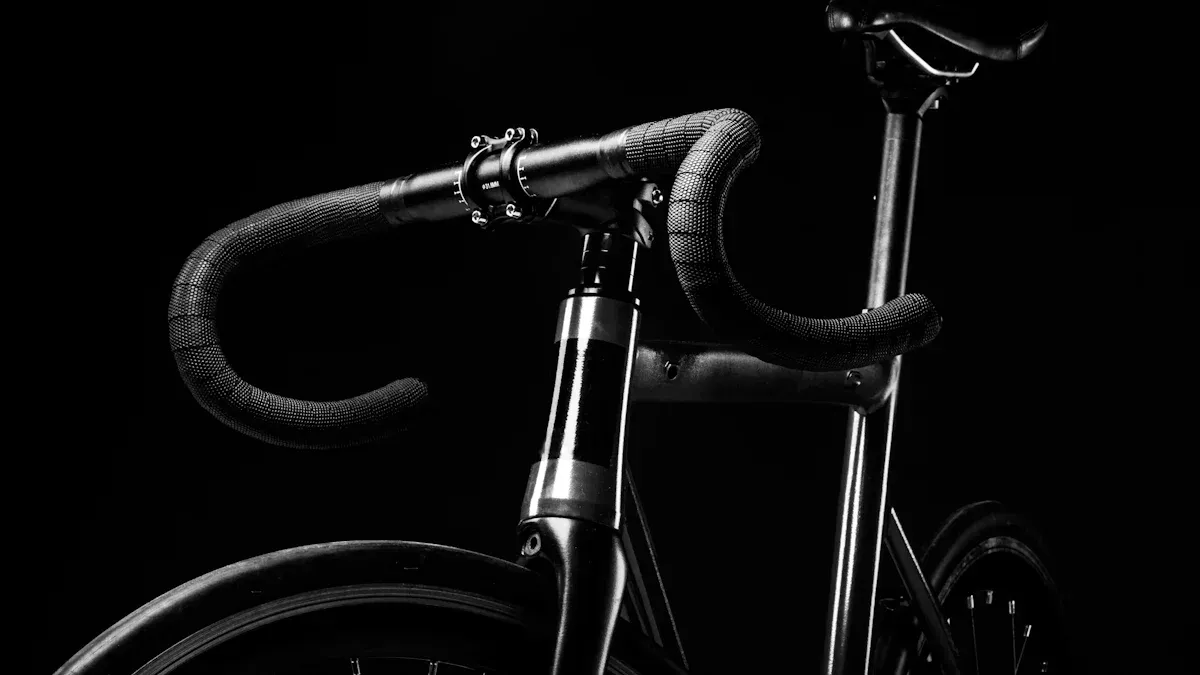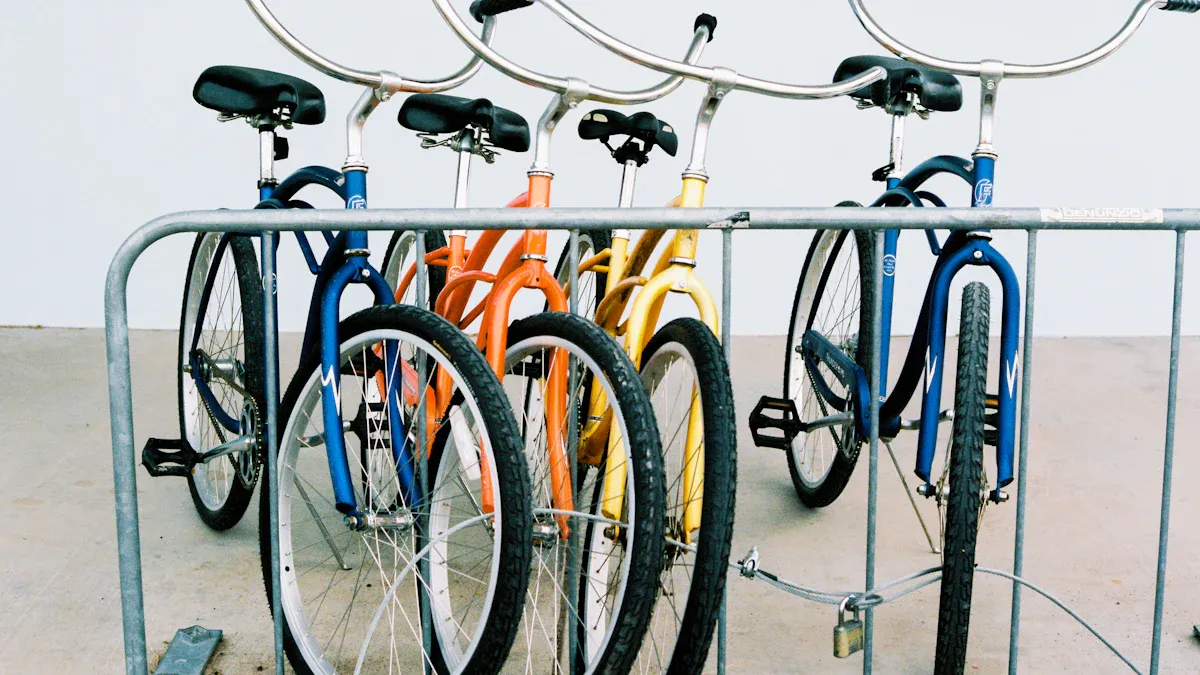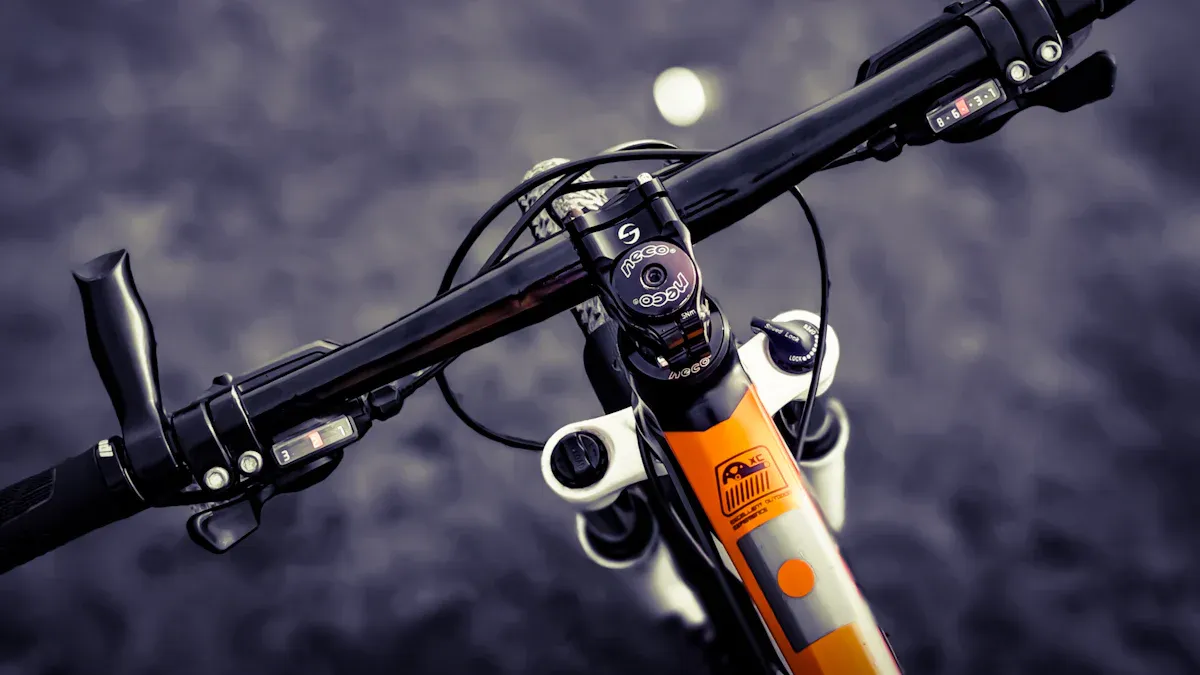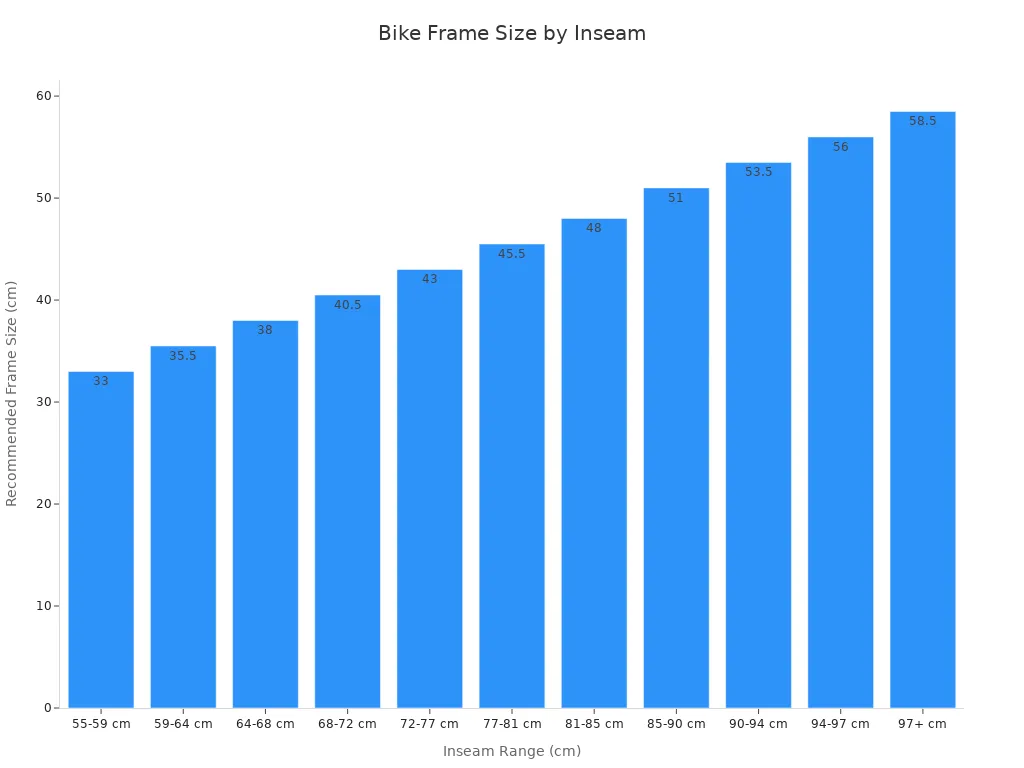
Choosing the right bike frame types starts with you. Think about how you use your bike and where you like cycling. Your comfort depends on finding the perfect fit. Every rider has different needs, so measure yourself and match your bike to your size. Look at frame materials, geometry, and budget. Safety and performance improve when you fit your bike correctly. Enjoy cycling and make sure your bike supports your goals.
Tip: Always test ride a bike to check fit before you decide.
Key Takeaways
Pick a bike frame type that matches how you ride and where you ride. This helps you feel comfortable and ride better. – Choose frame materials that are not too heavy or too weak. Make sure they fit your budget and needs. – Measure your height and inseam well. This helps you get the right bike frame size. The right size keeps you safe and comfortable. – Try riding bikes before you buy one. This lets you see if the bike fits and feels good. You can also check how it handles. – Think about getting a professional bike fitting. This can help you sit better on your bike. It can stop pain and help you ride longer and safer.
Bike Frame Types

Picking the right bike frame type helps you ride better. It also makes you feel more comfortable. Each bike frame type works best for certain places and ways of riding. The most common types are road, mountain, hybrid, and specialty frames. Look at the table below to see the main types and how popular they are:
Frame Types | Description / Notes |
|---|---|
Mountain Bicycle | Common worldwide, built for rough terrain |
Hybrid Bicycle | Mixes features of road and mountain bikes |
Electric Bicycle | Growing fast, less common than muscular bikes |
Road Bicycle | Popular for commuting and recreation |
Others | Includes specialty frames like gravel, touring, BMX |
Road Frames
Road frames are made for speed and going far. You use these bikes mostly on smooth roads. They are light and shaped to help you go fast. Road bikes have drop handlebars and thin tires. These parts help you pedal easier and cut through the wind.
Note: Road frames are best for racing, fitness, and riding to work on pavement. They do not work well on bumpy or dirt roads.
Road frames come in different shapes. Race bikes have a lower handlebar. This makes you faster but can hurt on long rides. Endurance bikes have a higher handlebar and shorter top tube. This lets you sit up straighter and feel less sore. You can move the stem and handlebars to make your ride more comfy.
Road bike frames work well for:
Fast and long rides
Racing and touring
Riding to work on smooth roads
Mountain Frames
Mountain bike frames are tough and last a long time. You use them for riding on rough, steep, or bumpy ground. The shape helps you sit up straight and stay in control. Flat handlebars and wide, bumpy tires help you ride over rocks and dirt.
Feature/Aspect | Description/Details |
|---|---|
Frame Materials | Steel and titanium soak up bumps. Aluminum is light and stiff. Carbon fiber is strong and light. |
Suspension Travel Types | Short travel is for easy trails. Long travel is for hard trails and going downhill. |
Testing Standards | Frames must pass hard tests to make sure they are strong. |
Many mountain frames have suspension. Hardtail frames have shocks in the front only. Full-suspension frames have shocks in the front and back. These help you ride over bumps and keep you safe.
Mountain bike frames are good for:
Climbing and going down hills
Riding on trails and rocky ground
Riding in mud, dirt, and loose rocks
Hybrid Frames
Hybrid frames mix the best parts of road and mountain bikes. You sit up straight, so your back and neck do not hurt. The shape makes it easy to ride and feel good. Flat handlebars help you steer, especially in busy places.
Advantage | Explanation |
|---|---|
Helps you see better and feel less sore | |
Practical Mounts for Accessories | Lets you add racks, fenders, and lights for daily use |
Aluminum and steel are fast and strong | |
Disc brakes stop well in any weather | |
Versatility Across Terrains | Can ride on roads, gravel, and easy trails |
Hybrid frames use tires that are not too thin or thick. These tires let you ride on roads, gravel, and easy trails. You do not need to change bikes. Hybrid frames often have places to put racks and fenders, which is good for daily trips.
Hybrid bike frames are great for:
Riding in the city and doing errands
Fun rides on different surfaces
People who want one bike for many things
Specialty Frames
Specialty bike frames are made for special uses. These include gravel, touring, electric, folding, BMX, fat bikes, and tandem frames. Each one has a special shape and features for its job.
Gravel frames: Made for mixed ground, with a relaxed shape and room for wide tires. They are steady and comfy on long, rough rides.
Touring frames: Built to carry heavy bags far. They are strong, have a relaxed shape, and places for racks and bags.
Electric bike frames: Made to hold a motor and battery. They are strong and can carry more weight.
Folding frames: Small and easy to carry or store.
BMX and fat bike frames: BMX frames are strong for tricks. Fat bike frames have big tires for snow or sand.
Frame Model | Key Design Features | Riding Experience Enhancement |
|---|---|---|
Specialized Diverge | Future Shock suspension | Smooth ride on bumpy ground |
Trek Checkpoint | Adjustable dropout, IsoSpeed decoupler | Can change setup, smooths rough rides |
Salsa Warbird | Endurance shape, less shaking | Steady and comfy for long gravel rides |
Niner RLT 9 | Room for wide tires | Steady on smooth and rough ground |
Specialty frames have special shapes to help you feel better, stay steady, or go faster for certain rides. For example, gravel and touring frames have longer wheelbases and slacker head tubes. This makes the bike steadier and softer on bumps, so long rides feel better.
Tip: When picking a bike frame, think about how you ride and where you go most. The right shape and features will help you have more fun and stay safe.
Frame Materials

The frame material you pick changes how your bike feels. It also affects how well your bike works. Think about weight, how long it lasts, comfort, and price. Each material has its own good points for different riders.
Aluminum
Aluminum frames are light and do not cost too much. You see aluminum in many road, mountain, and e-bikes. This material does not rust, so your bike stays nice. Aluminum frames feel stiff, so you pedal with more power. But, the ride can feel rough on bumpy roads. Aluminum does not soak up bumps well. Over time, small cracks can form from stress. Most people like aluminum because it is a good deal for the price.
Feature | Aluminum Frame |
|---|---|
Weight | Moderate |
Durability | Good, but can fatigue |
Ride Quality | Stiff, less comfort |
Cost |
Tip: Aluminum alloy is the top pick for e-bikes in 2025. It is strong, light, and not too expensive.
Carbon Fiber
Carbon fiber frames are the lightest you can get. You notice this when you pick up the bike or ride uphill. Carbon fiber soaks up bumps, so your ride feels smooth. This material gives you both speed and comfort. Carbon fiber does not wear out like aluminum. But, it can break if you crash hard. Fixing carbon fiber costs more and takes longer. You pay more for carbon fiber because it is hard to make.
Feature | Carbon Fiber Frame |
|---|---|
Weight | Lightest |
Durability | Good, but brittle |
Ride Quality | Smooth, absorbs bumps |
Cost | $4,000 – $5,000+ |
Note: Carbon fiber frames help e-bike batteries last longer because they are so light.
Steel
Steel frames last a very long time. They are strong and soak up bumps well. Steel frames weigh more than aluminum or carbon fiber. You can fix steel frames if they bend or break. Steel costs less than carbon fiber and sometimes less than aluminum. You need to keep steel dry so it does not rust.
Feature | Steel Frame |
|---|---|
Weight | Heaviest |
Durability | Best, easy to repair |
Ride Quality | Very comfortable |
Cost | $1,200 – $3,000 |
Material for E-Bikes
Most e-bikes in 2025 use aluminum alloy. These frames are light, strong, and do not rust. Some fancy e-bikes use carbon fiber for speed and battery life. Steel frames are used for comfort and carrying heavy things. Titanium frames are light and strong, but they cost a lot.
Aluminum alloy: Most common, light, strong, affordable.
Carbon fiber: Lightest, smoothest ride, expensive.
Steel: Durable, comfortable, heavy.
Titanium: Premium, light, strong, costly.
Material | Weight Impact | Comfort | Durability | Battery Life | Cost |
|---|---|---|---|---|---|
Aluminum | Light | Stiff | Good | Good | Affordable |
Carbon Fiber | Very light | Smooth | Good | Best | Expensive |
Steel | Heavy | Soft | Best | Lower | Moderate |
Titanium | Light | Smooth | Best | Good | High |
Tip: Pick a frame material that fits your needs and budget. You will enjoy your ride more if you choose the right one for you.
Bike Frame Size
Choosing the correct bike frame size is the most important step for comfort and performance. You need to use your height and inseam to find the right frame size. If you skip this step, you risk pain, injury, and poor cycling efficiency. Let’s break down how to measure bike size, why stand-over height matters, and how professional bike fitting can help you ride better.
Choose the Right Size
You start by measuring your height and inseam. Your inseam is the distance from the floor to your crotch. This is one of the essential body measurements for bike sizing. Use a book or ruler to help you get an accurate inseam measurement. Stand with your back against a wall, feet about 6 inches apart, and measure from the floor up to where you sit on the saddle.
Once you have your height and inseam, check a sizing chart for your bike type. Sizing guides match your height and inseam to the correct frame size. Here is a sample chart for mountain bikes:
Inseam (cm) | Height (cm) | Frame Size (cm) | Frame Size (Standard) |
|---|---|---|---|
55 – 59 | 150 – 160 | 32 – 34 | XXS |
59 – 64 | 150 – 165 | 35 – 36 | XS |
64 – 68 | 155 – 170 | 37 – 39 | S |
68 – 72 | 165 – 175 | 40 – 41 | S |
72 – 77 | 170 – 180 | 42 – 44 | M |
77 – 81 | 175 – 185 | 45 – 46 | M |
81 – 85 | 180 – 190 | 47 – 49 | L |
85 – 90 | 184 – 193 | 50 – 52 | L |
90 – 94 | 187 – 196 | 53 – 54 | XL |
94 – 97 | 190 – 200 | 55 – 57 | XL |
97+ | 195+ | 58 – 59 | XXL |
You can also use a quick formula to determine bike size:
Frame size = Leg inseam (cm) × 0.7
This formula gives you a good estimate if you do not have a chart. Always check the manufacturer’s sizing guides because sizes can change by brand and bike type.

Tip: Matching bike frame size to your height and inseam helps you avoid discomfort and injury. Nearly 80% of cyclists ride bikes that are too large or too small. Using the right frame size improves power, control, and cycling performance.
Stand-Over Height
Stand-over height is the space between the top tube of the bike and your body when you stand over the frame. You want about 2-5 cm (1-2 inches) of clearance for safety and comfort. This lets you plant both feet flat on the ground during stops or emergencies.
Stand-over height is more important for mountain and hybrid bikes, where you may need to get off quickly.
For road bikes, experienced riders sometimes use less clearance, but beginners should always check this measurement.
Some riders with shorter legs find stand-over height limits their frame choices.
In sudden stops, having enough stand-over clearance can prevent injury.
Wheel and tire size also affect stand-over height. Always check this before you buy. If you ignore stand-over height, you risk hitting the top tube and hurting yourself.
Note: Stand-over height is not the only factor in bike fit, but it boosts your confidence and safety, especially if you are new to cycling.
Professional Fitting
A professional bike fitting gives you the best comfort and performance. Experts use advanced tools like motion capture and pressure mapping to adjust bike fit to your body and riding style. They look at your height and inseam, but also check your reach, saddle height, and handlebar position.
Professional bike fitting helps you avoid numbness, chafing, and joint pain.
You get better posture, which means less back pain and knee strain.
A good fit improves your power, pedal stroke, and aerodynamics.
You reduce your risk of overuse injuries, like knee or hamstring problems.
Self-fitting with basic tools is a good start, but it cannot match the accuracy of a professional fitting. Experts also give advice on equipment and training. If you want to adjust bike fit for the perfect ride, a professional fitting is worth the investment.
Callout: Proper bike fitting helps you ride longer, faster, and safer. It also makes cycling more fun!
Choose a Bike for Perfect Fit
Riding Style
You should always start by thinking about how you plan to ride. If you want to race, look for frames with sharp angles and a lower handlebar. These bikes help you go fast and cut through the wind. For long rides or touring, you need a frame with a relaxed shape. This lets you sit up straighter and feel less tired. Gravel and mountain bikes use special geometry to help you stay stable on rough ground. The right frame material also matters. Carbon fiber is light and smooth for racing. Steel or titanium gives you comfort and strength for long trips. Matching your riding style to the frame type and geometry helps you get the best fit and ride quality.
Terrain
The places you ride change what kind of bike you need. If you ride on smooth roads, a road bike with thin tires and a stiff frame works best. For dirt, rocks, or trails, you need a mountain or gravel bike. These bikes have slanted top tubes and longer trails for better control. Shorter chainstays help you climb hills, but longer ones give you more space for bags on touring rides. Wide tires and more wheel clearance help you ride safely on rough or wet ground. Always check the geometry and sizing to make sure your bike matches your favorite terrain.
Budget
Your budget shapes your choices in the bike-buying process. Aluminum frames cost less and work well for many riders. Carbon fiber and titanium cost more but give you better comfort and lower weight. Think about how much you want to spend before you choose a bike. Try different bikes in your price range. Test rides help you find the best fit for your body and your wallet. Good sizing and comfort matter more than fancy parts. You will enjoy cycling more when your bike fits you and your needs.
Tip: Always test ride before you buy. Your comfort and bike fit matter most for a happy ride.
You can find the right bike frame by following these steps:
Match your bike type to your purpose, whether you want to commute, explore, or race.
Set your budget and choose frame materials that balance cost, comfort, and durability.
Use bike size charts and measure your body to get the best fit.
Test ride different bikes to check comfort and handling.
Adjust saddle and handlebars for better posture and cycling efficiency.
A professional fitting helps you avoid pain and boosts riding enjoyment. When you choose a bike that fits, you stay safe and enjoy cycling for years.
FAQ
What is the most comfortable bike frame for beginners?
You will feel most comfortable on a hybrid frame. It gives you an upright position and easy steering. You can ride on roads and light trails.
Tip: Try a test ride before you buy.
How do I know if my bike frame is the right size?
Stand over the bike and check for 1-2 inches of space between you and the top tube. Use your height and inseam to match the size chart.
Height (inches) | Frame Size (cm) |
|---|---|
5’2″–5’6″ | 48–52 |
5’6″–5’10” | 52–56 |
Which frame material lasts the longest?
Steel frames last the longest. You can repair them easily. They feel comfortable on rough roads.
🛠️ Steel is strong and durable for many years.
Do I need a professional bike fitting?
You should get a professional fitting if you ride often or feel pain. Experts adjust your bike for comfort and safety.
Note: A good fit helps you ride longer and avoid injuries.
See Also
Selecting The Perfect Bike Frame To Suit Your Needs
Key Factors That Determine The Ideal Bike Frame Fit
Features That Make Road Bike Frames Both Fast And Comfortable
